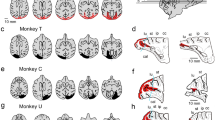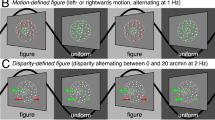Abstract
VISUALLY guided reaching requires complex neural transformations to link visual and proprioceptive inputs with appropriate motor outputs1,2. Despite the complexity of these transformations, hand–eye coordination in humans is remarkably flexible, as demonstrated by the ease with which reaching can be adapted to distortions in visual feedback. If subjects attempt to reach to visual targets while wearing displacing prisms, they initially misreach in the direction of visual displacement. Given feedback about their reaching errors, however, they quickly adapt to the visual distortion. This is shown by the gradual resumption of accurate reaching while the prisms remain in place, and by the immediate onset of reaching errors in the opposite direction after the prisms have been removed3. Despite an abundance of psy-chophysical data on adaptation to prisms, the functional localization of this form of sensorimotor adaptation is uncertain. Here we use positron emission tomography (PET) to localize changes in regional cerebral blood flow (rCBF) in subjects who performed a prism-adaptation task as well as a task that controlled for the sensory, motor and cognitive conditions of the adaptation experiment. Difference images that reflected the net effects of the adaptation process showed selective activation of posterior parietal cortex contralateral to the reaching limb.
This is a preview of subscription content, access via your institution
Access options
Subscribe to this journal
Receive 51 print issues and online access
$199.00 per year
only $3.90 per issue
Buy this article
- Purchase on Springer Link
- Instant access to full article PDF
Prices may be subject to local taxes which are calculated during checkout
Similar content being viewed by others
References
Kalaska, J. F. & Crammond, D. J. Science 255, 1517–1523 (1992).
Georgopoulos, A. P. Annu. Rev. Neurosci. 14, 361–377 (1991).
Redding, G. M. & Wallace, B. Percept. Psychophys. 44, 59–68 (1988).
Welch, R. B., Choe, C. S. & Heinrich, D. R. J. Exp. Psychol. 103, 700–705 (1974).
Redding, G. M., Clark, S. E. & Wallace, B. Cogn. Psychol. 17, 1–25 (1985).
Wilkinson, D. A. J. Exp. Psychol. 89, 250–257 (1971).
Baily, J. S. Q. J. Exp. Psychol. 24, 8–20 (1972).
Choe, C. S. & Welch, R. B. J. Exp. Psychol. 102, 1076–1084 (1974).
Beckett, P. A. J. Exp. Psychol. 6, 433–444 (1980).
Eidelberg, D. & Galaburda, A. M. Arch. Neurol. 41, 843–852 (1984).
Seltzer, B. & Pandya, D. N. Brain Res. 192, 339–351 (1980).
Colby, C. L., Duhamel, J. R. & Goldberg, M. E. J. Neurophysiol. 69, 902–914 (1993).
Thach, W. T., Goodkin, H. P. & Keating, J. G. Annu. Rev. Neurosci. 15, 403–442 (1992).
Zeffiro, T. Hum. Brain Mapp. suppl 1, 333 (1995).
Grafton, S. T., Mazziotta, J. C., Woods, R. P. & Phelps, M. E. Brain 115, 565–587 (1992).
Kawashima, R., Roland, P. E. & O'Sullivan, B. T. J. Neurosci. 14, 3462–3474 (1994).
Deiber, M. P. et al. Exp. Brain Res. 84, 393–402 (1991).
Stephan, K. M. et al. J. Neurophysiol. 73, 373–386 (1995).
Bonda, E., Petrides, M., Frey, S. & Evans, A. Proc. Natl Acad. Sci. USA 92, 11180–11184 (1995).
Parsons, L. M. et al. Nature 375, 54–58 (1995).
Corbetta, M., Miezin, F. M., Shulman, G. L. & Petersen, S. E. J. Neurosci. 13, 1202–1226 (1993).
Corbetta, M., Shulman, G. L., Miezin, F. M. & Petersen, S. E. Science 270, 802–805 (1995).
Pardo, J. V., Fox, P. T. & Raichle, M. E. Nature 349, 61–64 (1991).
Talairach, J. & Tournoux, P. Co-Planar Stereotaxic Atlas of the Human Brain (Thieme, New York, 1988).
Perenin, M. & Vighetto, A. Brain 111, 643–674 (1988).
Woods, R. P., Cherry, S. R. & Mazziotta, J. C. J. Comput. Assist. Tomogr. 16, 620–633 (1992).
Woods, R. P., Mazziotta, J. C. & Cherry, S. R. J. Comput. Assist. Tomogr. 17, 536–546 (1993).
Neter, J., Wasserman, W. & Kutner, M. H. Applied Linear Statistical Models (Irwin, Burr Ridge, Illinois, 1990).
Woods, R. P., Iacoboni, M., Grafton, S. T. & Mazziotta, J. C. in Quantification of Brain Function Using PET (eds Meyers, R., Cunningham, V. & Bailey, D.) 353–358 (Academic, New York, 1996).
Friston, K. J., Worsley, K. J., Frackowiak, R. S. J., Mazziotta, J. C. & Evans, A. C. Hum. Brain Mapp. 1, 210–220 (1994).
Author information
Authors and Affiliations
Rights and permissions
About this article
Cite this article
Clower, D., Hoffman, J., Votaw, J. et al. Role of posterior parietal cortex in the recalibration of visually guided reaching. Nature 383, 618–621 (1996). https://doi.org/10.1038/383618a0
Received:
Accepted:
Issue Date:
DOI: https://doi.org/10.1038/383618a0
This article is cited by
-
Direction of visual shift and hand congruency enhance spatial realignment during visuomotor adaptation
Experimental Brain Research (2023)
-
Improvement of phonemic fluency following leftward prism adaptation
Scientific Reports (2021)
-
Proprioceptive recalibration following implicit visuomotor adaptation is preserved in Parkinson’s disease
Experimental Brain Research (2021)
-
Reactive saccade adaptation boosts orienting of visuospatial attention
Scientific Reports (2020)
-
Visuomotor Prediction Errors Modulate EEG Activity Over Parietal Cortex
Scientific Reports (2018)
Comments
By submitting a comment you agree to abide by our Terms and Community Guidelines. If you find something abusive or that does not comply with our terms or guidelines please flag it as inappropriate.



